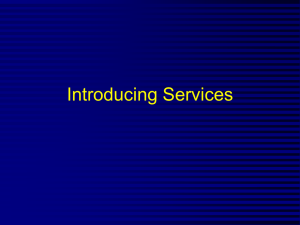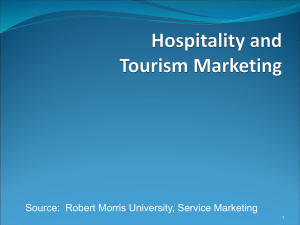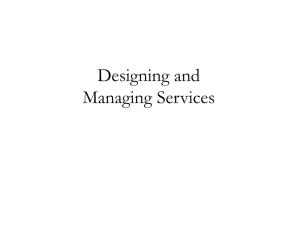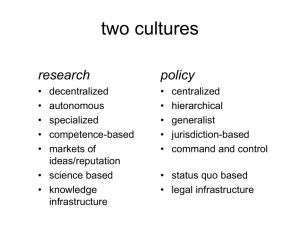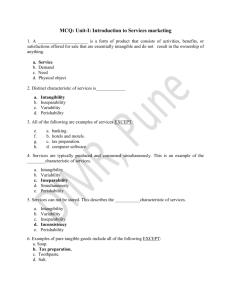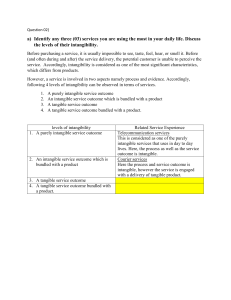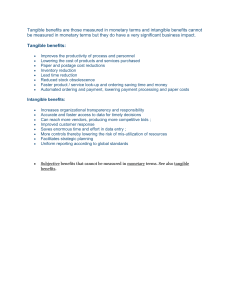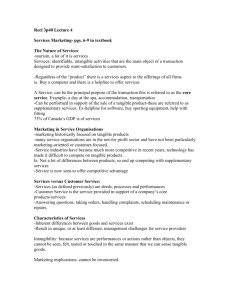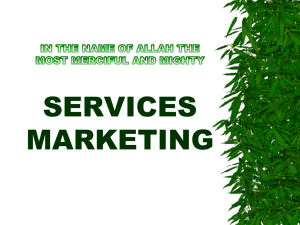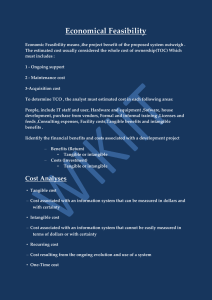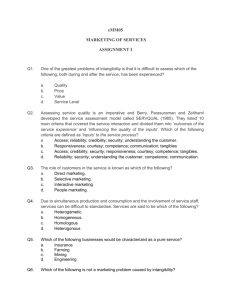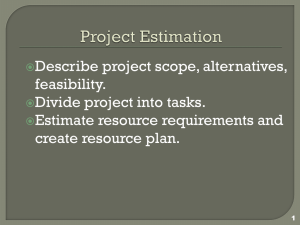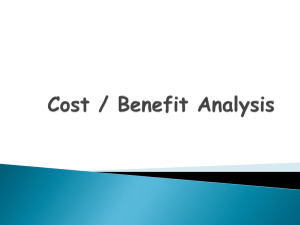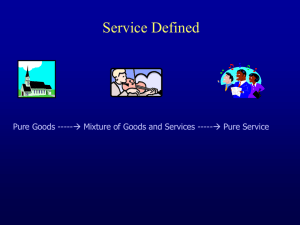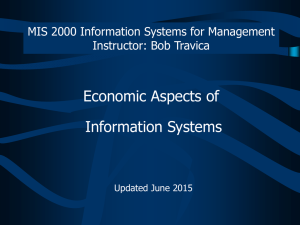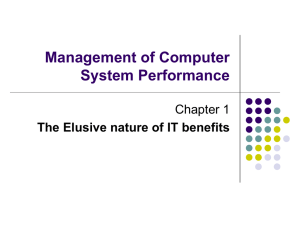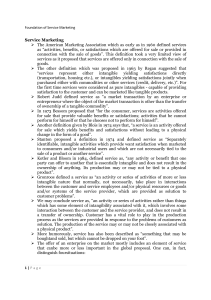MARKETING of SERVICES
advertisement
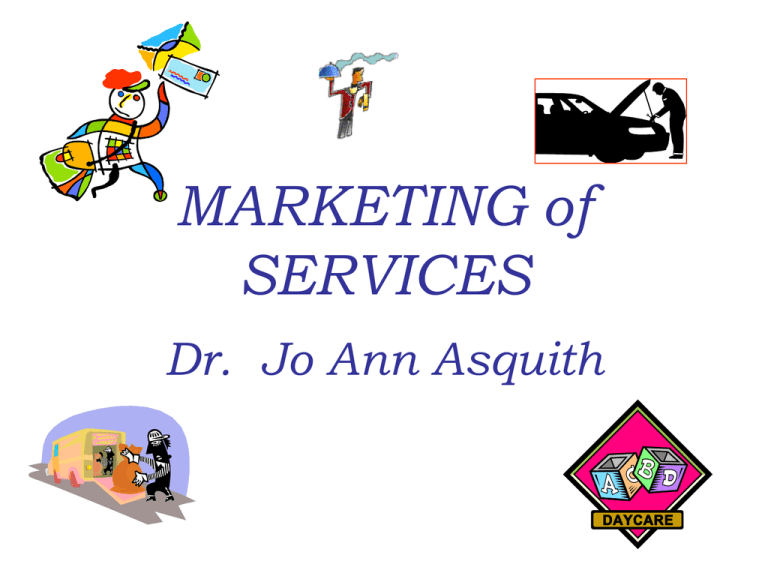
MARKETING of SERVICES Dr. Jo Ann Asquith Discussion Question (Posted on D2L) • • • • Introductions Describe your best service experience Describe your worst service experience What made the experiences different? The Service Management Decision Framework What Business Are We In? What Service Processes Can Be Used in Our Operation? Who Are Our Customers and How Should We Relate to Them? What Should be the Core and Supplementary Elements of Our Service Product? What Price Should We Charge for Our Services? How Should We Communicate What Our Service Has to Offer? What Are the Options for Delivering Our Service? How Can We Balance Productivity and Quality? How Should We Match Demand and Productive Capacity? What Are Appropriate Roles for People and Technology? How Can Our Firm Achieve Service Leadership? Distinctive Aspects of Service Management Introduction to Services Questions to Address • What are services? • Why services marketing? • Service and Technology • Characteristics of Services Compared to Goods • Services Marketing Mix • Staying Focused on the Customer What is a Service? Defining the Essence • An act or performance offered by one party to another (performances are intangible, but may involve use of physical products) • An economic activity that does not result in ownership • A process that creates benefits by facilitating a desired change in customers themselves, physical possessions, or intangible assets Some Industries in the Service Sector • Health Care – hospital, medical practice, dentistry, eye care • Professional Services – accounting, legal, architectural, education • Financial Services – banking, investment advising, insurance • Hospitality – restaurant, hotel/motel, bed & breakfast, – ski resort, rafting • Travel – airlines, travel agencies, theme park • Others: – hair styling, pest control, plumbing, lawn maintenance, counseling services, health club, news, entertainment The Service Sector • Includes businesses, government agencies, nonprofits • Jobs range from high-paid professionals and technicians to minimum-wage positions • Service organizations can be any size--from huge global corporations to local small businesses • In most countries, adds more economic value than agriculture, raw materials and manufacturing combined • In the USA -- world’s largest economy -- services account for 73% of GDP and 76% of jobs Marketing of Services A service is an activity or series of activities of more or less tangible nature that normally, but not necessarily, take place in interactions between the customer and the service employees and /or systems of the service provider, which are provided as solutions to customer problems. Overview: Why Services Matter • Services dominate U.S. and worldwide economies • Services are growing dramatically • Service leads to customer retention and loyalty • Service leads to profits • Services help manufacturing companies differentiate themselves Reasons for the Growth in Service Industries • • • • • • • 1. 2. 3. 4. 5. 6. 7. Increasing affluence More leisure time High % of women in the labor force Greater life expectancy Greater complexity of products Increasing complexity of life Greater concern about ecology and resource scarcity • 8. Increasing number of new products Factors Stimulating Competition and Innovation in the Service Economy • Government Policies (e.g., regulations, trade agreements) • Social Changes (e.g., affluent, time poor, seek experiences) • Business Trends – Manufacturers offer service – Growth of chains and franchising – Pressures to improve productivity and quality – More strategic alliances – Marketing emphasis by nonprofits – Innovative hiring practices • Advances in IT (e.g., speed, digitization, wireless, Internet) • Internationalization (travel, transnational companies) GDP by Industry in the USA 2010 2000 Agriculture, Forestry, Fishing and Mining 7% Manufacturing 16% Wholesale and Retail Trade 17% Government (Mostly Services) 12% Other Services 10% Finance, Insurance and Real Estate 20% S ER V I CES Transport, Utilities and Communications Business Health 8% Services 5% 5% Categories of Services • Type of Market - Consumer - Business • Degree of Labor – Intensiveness - People based - Equipment based • Degree of Customer Contact - High - Low • Skill of the Service Provider - Professional - Nonprofessional • Goal of the Service Provider - Profit - Nonprofit What is Service? The Old View • Service is a technical after-sale function that is provided by the service department. Old view of service = Customer Service Center Old: Service = wrench time What is Service? The New View • Service includes every interaction between any customer and anyone representing the company, including: Dealers Web site and any e-channel Interaction Salespeople Customer Billing and Accounting Personnel Service Employees Receptionists and Schedulers Management and executives Service Can Mean all of These • Service as a product • Customer service • Services as value add for goods • Service embedded in a tangible product Unique Service Characteristics • Heterogeneity • Customer Contact • Client – based relationships • An activity or process • Intangibility • Perishability • Inseparability of production and consumption Tangibility Spectrum Salt Soft Drinks Detergents Automobiles Cosmetics Fast-food Outlets Tangible Dominant Fast-food Outlets Intangible Dominant Advertising Agencies Airlines Investment Management Consulting Teaching Basic Differences between Goods and Services • Customers do not obtain ownership of services • • • • Service products are intangible performances--not objects Customers often actively involved in production process Other people may form part of product experience More variability in operational inputs and outputs--harder to improve productivity, control quality • Often difficult for customers to evaluate • Absence of inventories after production • Time factor is more important--speed may be key • Delivery systems include electronic and physical channels Implications of Intangibility Services cannot be inventoried Services cannot be patented Services cannot be readily displayed or communicated Pricing is difficult Implications of Heterogeneity Service delivery and customer satisfaction depend on employee actions Service quality depends on many uncontrollable factors There is no sure knowledge that the service delivered matches what was planned and promoted Implications of Simultaneous Production and Consumption Customers participate in and affect the transaction Customers affect each other Employees affect the service outcome Decentralization may be essential Mass production is difficult Implications of Perishability It is difficult to synchronize supply and demand with services Services cannot be returned or resold Internal Services • Service elements within an organization that facilitate creation of--or add value to--its final output • Includes: – – – – – – accounting and payroll administration recruitment and training legal services transportation catering and food services cleaning and landscaping • Increasingly, these services are being outsourced The “7Ps” of Integrated Service Management vs. the Traditional “4Ps” • Product elements • Price and other user outlays • Promotion and education • Place, cyberspace, and time • Process • People • Physical evidence Product • Physical good features • Quality level • Accessories • Packaging • • • • Warranties Product lines Branding Benefits Service Components Core The reason for being on the market. Facilitating Additional services that facilitate the use of the core. If facilitating services are lacking, the core service cannot be consumed Support Are used to the value and/or differentiate the use of the core service. Price and Other User Costs Managing Customer Outlays Relative to Corporate Revenues • Quoted price level and trade margins • Discount terms • Price-setting mechanism – determined by seller – negotiation/barter – auction/reverse auction • Credit terms • Strategies to minimize other user costs – out-of-pocket financial expenses (e.g., travel, phone) – time investments and mental/physical effort – negative sensory experiences Pricing Issues • • • • • • • How much should be charged for this service? What should be the basis of pricing? Who should collect payment? Where should payment be made? When should payment be made? How should payment be made? How should prices be communicated to the target market? Promotion and Education Inform, Educate, Persuade, and Remind • Marketing communication tools – media elements (print, broadcast, outdoor, etc.) – Social media and websites – personal selling, customer service – sales promotion – publicity/PR • Imagery and recognition – branding – corporate design • Content – information, advice – persuasive messages – customer education/training Promotion Mix Elements • Salespeople – Number – Training - Selection - Incentives • Advertising – Types of ads – Targets - Copy thrust - Media types • Sales Promotion • Publicity/ Public relations Place, Cyberspace, and Time Delivery Decisions: Where, When, and How • Channel type and exposure • Geographic locations served • Service schedules • Physical channels • Electronic channels • Customer control and convenience • Channel partners/intermediaries Expanded Mix for Services -the 7 Ps • • • • Product Price Place Promotion • People • Process • Physical Evidence People The Human Side of the Enterprise • The right employees performing tasks well – job design – recruiting/selection – training – motivation – evaluation/rewards – empowerment/teamwork • The right customers for the firm’s mission – fit well with product/processes/corporate goals – appreciate benefits and value offered – possess (or can be educated to have) necessary skills – firm is able to manage customer behavior Process Method and Sequence in Service Creation and Delivery • Design of activity flows • Number and sequence of actions for customers • Providers of value chain components • Nature of customer involvement • Role of contact personnel • Role of technology, degree of automation Physical Evidence Providing tangible evidence of service performances • Create and maintaining physical appearances – buildings/landscaping – interior design/furnishings – vehicles/equipment – staff grooming/clothing – other tangibles • Select tangible metaphors for use in marketing communications Physical Evidence • Facility design – Aesthetics – Functionality – Ambient Conditions • Equipment • Signage • Employee dress • Other tangibles – – – – Reports Business Cards Statements Guarantees Ways to Use the 7 Ps Overall Strategic Assessment Specific Service Implementation • How effective is a firm’s services marketing mix? • Is the mix well-aligned with overall vision and strategy? • What are the strengths and weaknesses in terms of the 8 Ps? • Who is the customer? • What is the service? • How effectively does the services marketing mix for a service communicate its benefits and quality? • What changes/improvements are needed? Relating the 7Ps to the Service Decision Framework WHAT BUSINESS ARE WE I N ? What Service Processes Can Be Used in Our Operation? (PROCESS) Who Are Our Customers and How Should We Relate to Them? What Should be the Core and Supplementary Elements of Our Service Product? (PRODUCT ELEMENTS) What Price Should We Charge? (PRICE AND OTHER USER OUTLAYS) How to Communicate? (PROMOTION & EDUCATION, PHYSICAL EVIDENCE) Options for Delivery? (PLACE, CYBERSPACE & TIME, PHYSICAL EVIDENCE) How Can We Balance PRODUCTIVITY AND QUALITY? How Should We Match Demand and Productive Capacity? What Are Appropriate Roles for People and Technology? (PEOPLE) How Can Our Firm Achieve Service Leadership? Service Decision Framework What Business Are We In? • With what industry is our service associated? • With what other goods and services do we compete? • What forces for change do we face? • What solutions do we offer to meet customer needs? (How do we create value?) The Services Marketing Triangle Company (Management) Internal Marketing “setting the promise” “enabling the promise” Employees External Marketing Interactive Marketing “delivering the promise” Customers Ways to Use the Services Marketing Triangle Overall Strategic Assessment Specific Service Implementation • How is the service organization doing on all three sides of the triangle? • What is being promoted and by whom? • Where are the weaknesses? • Are the supporting systems in place to deliver the promised service? • What are the strengths? • How will it be delivered and by whom? Challenges and Questions for Service Marketers • • • • • • • • • How can service quality be defined and improved? How can services be designed and tested effectively? How does the firm accommodate fluctuating demand? How can the organization ensure the delivery of consistent quality service? How can the firm best select and motivate service employees? How should prices be set? How can the firm be certain it is communicating a consistent and relevant message? How does the firm communicate quality and value to the customers? Finding a balance between standardization versus customization The Service Profit Link Employee Satisfaction and Loyalty Service Value Customer Satisfaction and loyalty Profits and Growth The Service Profit Link “Putting the Service-Profit Chain to Work” by James L. Heskett; Thomas O. Jones; Gary W. Loveman; W. Earl Sasser Jr.; Leonard A. Schlesinger
